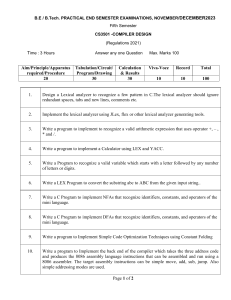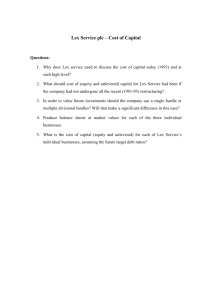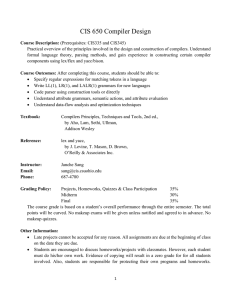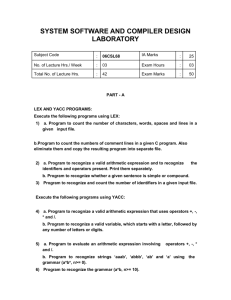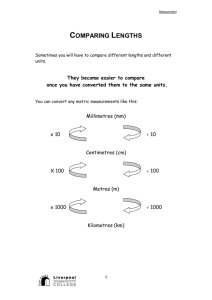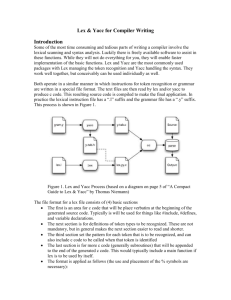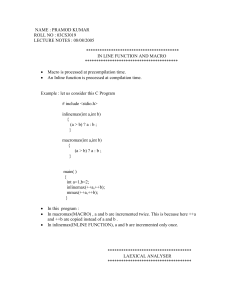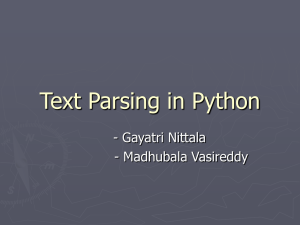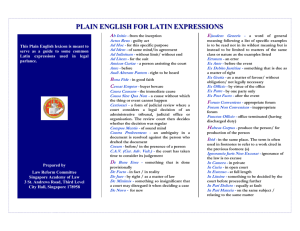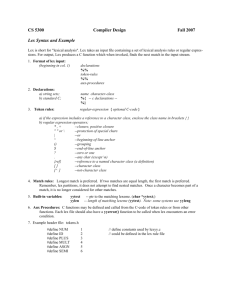viva questons
advertisement
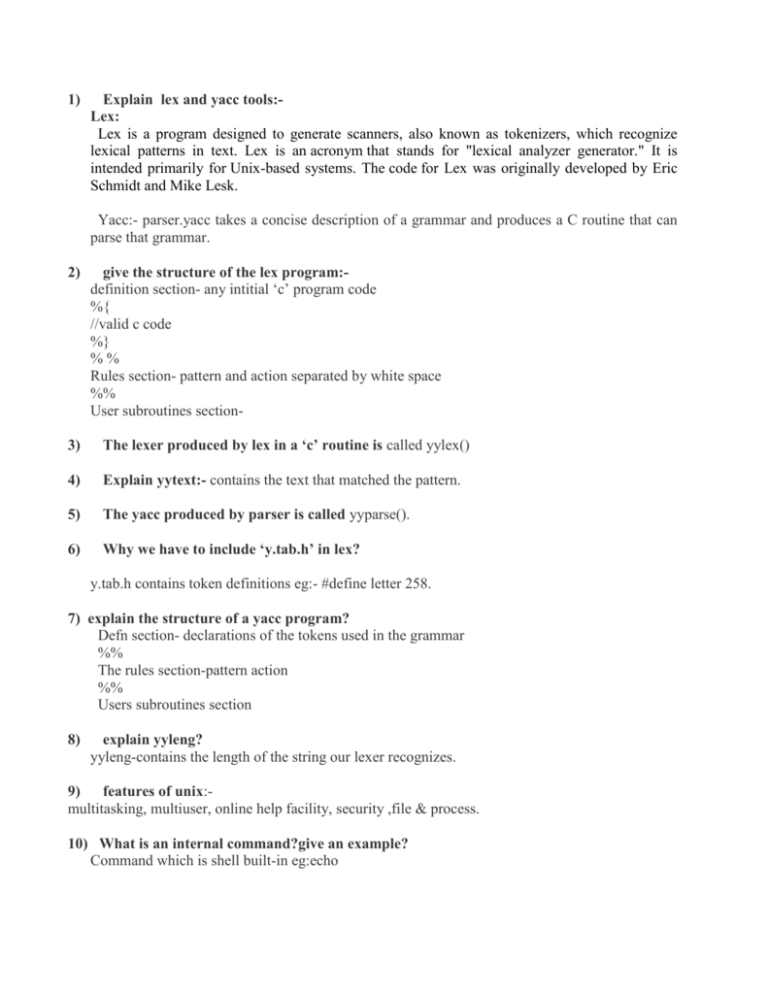
1)
Explain lex and yacc tools:Lex:
Lex is a program designed to generate scanners, also known as tokenizers, which recognize
lexical patterns in text. Lex is an acronym that stands for "lexical analyzer generator." It is
intended primarily for Unix-based systems. The code for Lex was originally developed by Eric
Schmidt and Mike Lesk.
Yacc:- parser.yacc takes a concise description of a grammar and produces a C routine that can
parse that grammar.
2)
give the structure of the lex program:definition section- any intitial ‘c’ program code
%{
//valid c code
%}
%%
Rules section- pattern and action separated by white space
%%
User subroutines section-
3)
The lexer produced by lex in a ‘c’ routine is called yylex()
4)
Explain yytext:- contains the text that matched the pattern.
5)
The yacc produced by parser is called yyparse().
6)
Why we have to include ‘y.tab.h’ in lex?
y.tab.h contains token definitions eg:- #define letter 258.
7) explain the structure of a yacc program?
Defn section- declarations of the tokens used in the grammar
%%
The rules section-pattern action
%%
Users subroutines section
8)
explain yyleng?
yyleng-contains the length of the string our lexer recognizes.
9) features of unix:multitasking, multiuser, online help facility, security ,file & process.
10) What is an internal command?give an example?
Command which is shell built-in eg:echo
11) what is an external command?give a example?
Command which resides in other directories-eg:cd in /bin
12) what is an absolute path name?give an example?
A file name identification with respect to the root. Eg:- /home/kumar/f1
13) what is an relative path name?
A file identification not with respect to the root.
13) differentiate the commands cp and mv?
cp- copy the files
mv- renaming the file.
14) explain mkdir command?
Used to create a directory
Eg:mkdir m1,m2
15) what are tokens or terminal symbols?
Symbols that appear in the input are returned by the lexer are terminal symbols.
16) what type of data structures is used by shift/reduce parsing?
Stack.
17) shell- it is a command interpreter
kernel- is the core of the operating system.
18) what is lexical analyzer?
Lex taking a set of descriptions of possible tokens and producing a ‘C” routine is called a lexical
analyzer (or) lexer (or) scanner.
19) define grammer?
The list of rules that define the relationship that the program understands is a grammar.
20) what is symbol table?
Symbol table: A data structure used by a compiler to keep track of semantics of variables., a
common structure in lex and yacc applications.
21) what is pseudo token
A pseudo token standing for unary minus, has no associativity is at the highest precedence.
22) what does $$ represents?
$$ represents the value of the left hand side.
23) What are shell scripts?
Using a program, we can run more than one command.
24) what is the usage of grep command?
grep command is used to search a pattern in a database.
25) what is exit status command?
exit 0- return success ,command executed successfully.
exit 1 – return failure.
26) what are daemons?
They are one system processes
27) uname:- tells you the name of the unix system you are using.
28) umask:- tells unix which permissions to give to files and directories you create.
29) tty- displays the device name of your terminal
30) vi editor- (visual editor)- used to write programs.
31) What is a shell?
Shell is a interface between user and the kernel. Even though there can be only one kernel ; a
system can have many shell running simultaneously . Whenever a user enters a command through
keyboard the shell communicates with the kernel to execute it and then display the output to the
user
32) What are the different types of commonly used shells on a typical linux system?
csh,ksh,bash,Bourne . The most commonly used and advanced shell used today is “Bash” .
33) What is the equivalent of a file shortcut that we have on window on a Linux system?
Shortcuts are created using “links” on Linux. There are two types of links that can be used
namely “soft link” and “hard link
34) What is the difference between soft and hard links?
Soft links are link to the file name and can reside on different filesytem as well; however hard
links are link to the inode of the file and has to be on the same filesytem as that of the file.
Deleting the orginal file makes the soft link inactive (broken link) but does not affect the hard
link (Hard link will still access a copy of the file)
35) How will you pass and access arguments to a script in Linux?
Arguments can be passed as:
scriptName “Arg1” “Arg2”….”Argn” and can be accessed inside the script as $1 , $2 .. $n
36) What is the significance of $#?
$# shows the count of the arguments passed to the script.
37) What is the difference between $* and $@?
$@ treats each quoted arguments as separate arguments but $* will consider the entire set of
positional parameters as a single string.
38) What is the difference between $$ and $!?
$$ gives the process id of the currently executing process whereas $! shows the process id of the
process that recently went into background.
39) What are zombie processes?
These are the processes which have died but whose exit status is still not picked by the parent
process. These processes even if not functional still have its process id entry in the process table.
